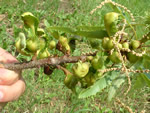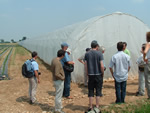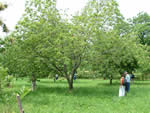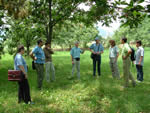
EPPO Workshop on Dryocosmus kuriphilus
Cuneo (IT), 2006-06-26/28
17 experts from 11 EPPO countries, the USA and the EU Commission participated in this Workshop led by the EPPO Secretariat. The Workshop discussed the mechanisms of spread of Dryocosmus kuriphilus based on experiences of the pest in Japan, the USA and the Piedmont region of Italy. Dispersal occurs due to the flight capacity of the pest, wind and human activity, the last two factors being the most important. The pest is causing serious economic, environmental and social damage. The Workshop concluded that the eradication or containment of the pest in the natural environment is impossible to attain. Pest control by insecticides seems not to be a feasible option. The Japanese experience of using introduced parasitoids (especially Torymus sinensis) seems promising in reducing pest populations to an acceptable level. In the USA, biological control is considered by growers to be the most promising method of pest control whether by Torymus sinensis or by other native parasitoids.
The Workshop recommended following phytosanitary measures to delay the spread of Dryocosmus kuriphilus by trade of plants and/or plant products within the EPPO region: “Country freedom”, “Area freedom” and “Grown under specified protected conditions (under an insect-proof net)”. The Piedmont trials have shown the last measure to be a promising one for growing healthy plants for planting. Having taken into account the potential rate of natural spread of the pest and the difficulty of its early detection, the idea of setting up buffer zones to protect pest free places of production was not considered feasible. The use of selected phytosanitary measures would help to buy time in order to develop biological control measures. However, it was recognized that biological control will, at best, only limit populations of the pest in infested areas to an acceptable level.
The Workshop developed further recommendations for work in the future.

galls on a chestnut
branch

plants for planting grown
under insect-proof net

damaged
chestnut tree

participants in a damaged
chestnut garden
Presentations
The chesnut gall wasp Dryocosmus kuriphilus Yasumatsu, 1951
G. Bosio, Italy
Dryocosmus kuriphilus: biological aspects
L. Picciau, Italy
Natural dispersal of cynipid wasps (Hymenoptera: Cynipidae)
G. Melika, Hungary
Introduction and spread of Dryocosmus kuriphilus in Northern America, possibilities for eradicating or containing the pest
L. Rieske-Kinney, USA
Spread of Dryocosmus kuriphilus in Piedmont
G. Bosio, Italy
Attacks of the oriental chestnut gall wasp on Castanea in south Piedmont
G. Bosio, G. Brussino, M. Baudino, R. Gordano, F. Ramello (Italy), G. Melika (Hungary)
Phytosanitary measures against Dryocosmus kuriphilus in Piedmont
G. Bosio, Italy
Situation with Dryocosmus kuriphilus in Slovenia
J. Jaksa, Slovenia
Generalist widespread parasitoids attacking Dryocosmus kuriphilus and oak galls
A. Aebi, Switzerland
Research on biological control with Torymus sinensis introduction
A. Alma, A. Quacchia, Italy
Research on insecticide efficacy and on the protection of young chestnuts with nets
L. Picciau, Italy
Research on sensibility of different chestnut cultivars to Dryocosmus kuriphilus
R. Botta, Italy
